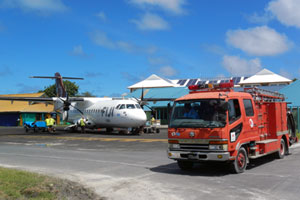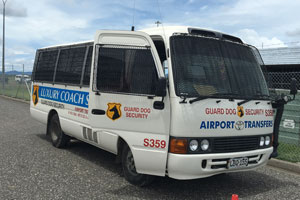The beginning and end of most international journeys, whether short business trips or longer overseas assignments, involve spending time at airports. As an International Data Researcher (IDR), I do this more than most – and it is often the most complicated and frustrating part of an overseas data collection trip. Indeed, I have visited or travelled through over 500 airports in my many years as an IDR. More often than not they are the huge international airports that most of us are used to, but I’ve also been through my fair share of less advanced airports that are often the only way to get to and from many developing nations. This blog post will look at what I have picked up from my years travelling through airports across the globe and will hopefully offer some helpful tips that may be of use to those who find themselves going abroad to a new destination in the near future.
 It may sound obvious, but to help make the airport experience as smooth as possible it’s always best to plan ahead! First of all, ensure well in advance that you have the correct visas, up-to-date passport and other essential paperwork because many airlines will not let you board a flight without them.
It may sound obvious, but to help make the airport experience as smooth as possible it’s always best to plan ahead! First of all, ensure well in advance that you have the correct visas, up-to-date passport and other essential paperwork because many airlines will not let you board a flight without them.
Also, ensure that your vaccinations are up to date. Many countries require an official yellow fever certificate before they will let you enter. This is something I once found out to my chagrin when flying from Paris to French Guiana in South America as I was unaware that the Air France flight would not let me board without an original yellow fever certificate. I even had a colour photocopy, but this wouldn’t cut it. Fortunately, I had enough time to spare at the airport to visit a doctor and have another vaccination to get approval to board the plane. Needless to say, I now carry my original certificate with me everywhere I go.
Getting to and from the airport is one of the most important things to consider for us IDRs, especially in more remote locations where transport infrastructure may not be what you’re used to back home. I’ve had a few ‘near misses’ in my time where I’ve managed to get to the check-in counter seconds before they close. The most stressful experience for me was several years ago on the Caribbean island of St Maarten. All was going well, and I got to the airport in plenty of time only to scan the departures boards in vain for my flight. After asking around it was apparent that my flight was leaving from the much smaller airport on the other side of the island! Luckily a local taxi driver was up to the challenge and got me there in the nick of time. He got a hefty tip too!
 Another important aspect of getting to and from airports is security. It’s often necessary to travel through less secure areas of a city to reach the airport from your hotel or vice versa, and when arriving in many locations it’s imperative that you plan ahead, arranging for someone to meet you at the airport. In Lagos, for example, it is not recommended to drive to or from the airport in hours of darkness and in Lae, Papua New Guinea, IDRs are even collected at the airport in an armoured van to avoid being attacked by local gangs. My colleague, Hugh, previously wrote a blog on his various taxi experiences throughout his time as an IDR, and offered some useful advice on the different ways of approaching these situations around the world.
Another important aspect of getting to and from airports is security. It’s often necessary to travel through less secure areas of a city to reach the airport from your hotel or vice versa, and when arriving in many locations it’s imperative that you plan ahead, arranging for someone to meet you at the airport. In Lagos, for example, it is not recommended to drive to or from the airport in hours of darkness and in Lae, Papua New Guinea, IDRs are even collected at the airport in an armoured van to avoid being attacked by local gangs. My colleague, Hugh, previously wrote a blog on his various taxi experiences throughout his time as an IDR, and offered some useful advice on the different ways of approaching these situations around the world.
Once you’ve got yourself safely to the airport, that is often when the frustration really sets in. Over the last 20 years, many aspects of airport processes have been speeded up with the help of technological advances such as ePassport gates – gone are the days of queuing for hours when all you want to do is get to the coffee shop.
However, over the years I’ve had a few experiences of a more serious nature than just having to queue. One that stands out is when I was going through the security process at Nouakchott Airport in Mauritania. I was taken in to a closed-off area where a man with a rifle proceeded to seize my wallet and demand a cash bribe. I felt really uncomfortable with this as it was an airport where presumably those with guns should be professionals. I told my new acquaintance as such, grabbed my wallet back and fled into the safety of the departure lounge. Luckily, the man didn’t follow me but nonetheless I would recommend caution if you ever find yourself in a similar situation!
Upon landing in a new and alien place it’s best to know beforehand the basic procedures for navigating the airport successfully and what your onward transport options are. Fortunately for a monolinguist like myself nearly all airports in the world have directions and signs in English as well as the local language, so that’s always a help. The arrivals hall can often feel like a chaotic maelstrom of crowds and disorder, but I always try my hardest to avoid looking ‘out of place’ as much as possible. International airports can attract those looking to take advantage of new arrivals unaccustomed to their new surroundings, no matter what country you might be arriving in.
Once you’ve collected your luggage (always keep the baggage tag as in many countries they won’t let you take your luggage without it!) the next step would usually be to source the local currency. If ATMs are not available, then hopefully you’ve planned ahead and brought foreign currency to exchange (USD and EUR are normally the best to have) but always know the exchange rate in advance so that you don’t get ripped off.
After that, you’re about ready to start exploring your new environment. However, one final piece of advice would be to download offline maps. Speaking from my own experiences, these can often prove indispensable in the more remote places where you need to be able to check you’re heading in the right direction to your hotel without internet access!
FIND OUT MORE
If you’re preparing to live or work in another country, whether short-term, long-term or on a permanent basis, ECA's Country Profiles are in-depth briefing documents that provide essential information for over 125 different countries around the world.
As part of our Country Profiles subscription, we have also introduced a new flight times app showing the shortest flight time between two destinations.
Your assignees can see Country Profiles and benefit from their interactive features if your company subscribes to Expatriate Services, a website unique to your company that can be accessed through your intranet.
To find out more about Expatriate Services and customisation, please contact us.
Please contact us to speak to a member of our team directly.